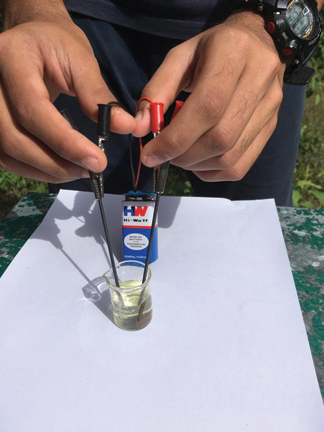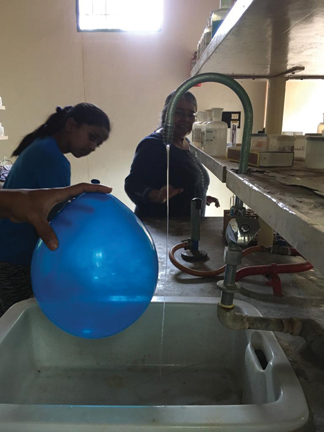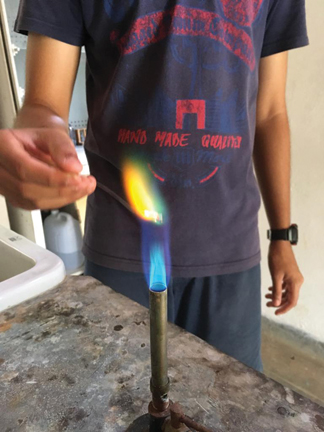Yasmin Jayathirtha
All of us who teach science would enjoy doing it through activities and dream of being able to do what we read about; “In Finland they have interdisciplinary science till college,” “You can teach all of science through learning about and maintaining a bicycle,” “You can teach science through sports, cooking, whatever….”

But after a while, ‘reality’ hits; students need certification, certification needs exams and exams need definitions, facts …. So one loses heart and thinks there is no way out except to use the textbooks and maybe do a few activities and demonstrations. And this approach gives a very skewed view of science, because it more or less hides the process of science from the students and makes the ‘facts’ paramount. The problem with this is that when you are told to ‘believe in science’, it is the facts that you think of and not the process. How do we teach science so that the process of science – observation, induction, model building/breaking and deduction – becomes a part of the learning and students realize that the facts and theories of science are models that can be used to predict what will happen ‘if’. And that it is also our present best explanation of what we see around us.
How do we reconcile all this? I would like to outline two possibilities – project based or activity based science. This has been tried in different ways in the school I was teaching and has worked fairly well. This is for the middle school, i.e., classes 6-8. Why for these classes? Primary school children should be doing things with their hands and observing and playing with material. When they come to middle school, their ability to abstract and do thought experiments is greater and one can challenge them. This is also the time when the pressure of certification exams is not too much. What would science classes look like? In activity based science, general topics in the usual subjects – physics, chemistry and biology – are done through activities with minimum theory. The topics given below are chosen to be both fundamental to the subject and with doable activities. The activities are the usual ones outlined in textbooks.

Physics: Measurements of length, mass, volume and time. Measurement of density by various methods. Forces acting on substances. The lever law, stretching of a spring. Simple machines. States of matter and the effect of heat on solids, liquids and gases. Transfer of heat. Types of energy and their interconversions. Sound and its velocity. Light, reflection, refraction and the laws of reflection, colours. Magnetism, electricity, circuits, motors. These are all topics that are learnt in classes 8-10 usually with a few demonstrations and calling the students attention to daily life examples. What is the advantage of doing the activities in the earlier classes and then going on to learn about them formally? One, of course, is that it is more real to the students and they will have generated the data. They may not yet know what the results to be expected are and so in a sense are exploring. They are also learning how to set up the experiment (not always an easy task) and collect data. The other skills are those of presenting the data in a form that can be readily used – ordering it, tabulating it and then seeing the patterns. In this process, there is room for ‘what if’ questions. As an example – some students were studying the centre of gravity and had a metre ruler balanced on the edge of the table. One of them asked, “What if we move it a millimetre towards the edge?” and tried it out. Another blew lightly on the overhanging edge, watched it teeter, stopped blowing, watched it settle back. This was quite dramatic and I am sure, unforgettable. The process also allows them to make sense of data that they have not collected and use it to make deductions.
Having followed this approach for a few years, I noticed that teaching with the exam in mind became much easier, because the understanding had already taken place earlier and they were able to follow the arguments more easily. Classes 9 and 10 became the classes for consolidating all that the students have experienced and thought about, with some new ideas.
Chemistry and biology can be studied in a similar way.
Chemistry: Physical and chemical changes, separation of mixtures, states of matter and the kinetic model, acids, bases and neutral substances, properties of metals and non-metals, activity series, rates of reactions, types of reactions.

Biology: Classification of organisms, making of identification keys, study of habitats, human systems, senses – taste, hearing, sight and smell with activities. Food and food tests.
This way works quite well and gives the students a feel of experimental work and shows them how to use data for building models. The drawback of this approach is that it keeps the learning in the traditional disciplines narrow. It is not exploratory in any way and works with known knowledge and ideas. A better way of looking at science in an exploratory manner might be to study themes – an interdisciplinary study of topics. Themes can include topics like water, air, light and colour, energy, forces, states of matter, electricity, food, biogeochemical cycles, properties of materials. A topic can be studied in an exploratory manner for a term. To see how it will work let us pick a theme like water: we can start by asking what the students know, what they would like to find out, begin by studying the physical properties of water, its uses, the role of water in the environment and so on. This does not narrow down the science to disciplines – students will be learning about the physical states of water and the biological importance of the states in a seamless manner. They will also learn how to look up information and how to follow their curiosity and how to present it to others. It locates the science in their environment and makes it easy to relate what they are learning with how they live their lives. I am really enthused by the idea that they learn science by looking at themselves and their environment.
After having taught in schools, the author has now moved to working with student teachers. She says it is interesting to explain to others and herself the methods of teaching. She continues to be interested in sharing her fascination with chemistry and its teaching with others. She can be reached at yasmin.cfl@gmail.com.
